Discover 20 hidden attractions, cool sights, and unusual things to do in Tunisia. Don't miss out on these must-see attractions: Bardo National Museum (Tunis), Medina of Sousse (Sousse) or Medina of Tunis (Tunis).
Below, you can find the list of the most amazing places you should visit in Tunisia.
Table of Contents
Bardo National Museum, Tunis

Also known as: المتحف الوطني بباردو
Museum of Tunisian heritage and Carthage. The Bardo National Museum is a museum of Tunis, Tunisia, located in the suburbs of Le Bardo.
It is one of the most important museums in the Mediterranean region and the second museum of the African continent after the Egyptian Museum of Cairo by richness of its collections. It traces the history of Tunisia over several millennia and across several civilizations through a wide variety of archaeological pieces.
Housed in an old beylical palace since 1888, it has been the setting for the exhibition of many major works discovered since the beginning of archaeological research in the country. Originally called Alaoui Museum (Arabic: المتحف العلوي, romanized: al-Matḥaf al-ʿAlawī), named after the reigning bey at the time, it takes its current name of Bardo Museum after the independence of the country even if the denomination is attested before that date.
The museum houses one of the largest collections of Roman mosaics in the world, thanks to excavations at the beginning of 20th century in various archaeological sites in the country including Carthage, Hadrumetum, Dougga and Utica. Generally, the mosaics of Bardo, such as the Virgil Mosaic, represent a unique source for research on everyday life in Roman Africa. From the Roman era, the museum also contains a rich collection of marble statues representing the deities and the Roman emperors found on different sites including those of Carthage and Thuburbo Majus.
The museum also houses pieces discovered during the excavations of Libyco-Punic sites including Carthage, although the National Museum of Carthage is the primary museum of the Carthage archaeological site. The essential pieces of this department are grimacing masks, terracotta statues and stelae of major interest for Semitic epigraphy, and the stele of the priest and the child. The museum also houses Greek works discovered especially in the excavations of the shipwreck of Mahdia, whose emblematic piece remains the bust of Aphrodite in marble, gnawed by the sea.
The Islamic Department contains, in addition to famous works such as the Blue Qur'an of Kairouan, a collection of ceramics from the Maghreb and Anatolia.
In order to increase the reception capacity and optimize the presentation of the collections, the museum is the subject of a vast operation which was to be completed initially in 2011 but was not finished until 2012 due to the Tunisian Revolution. The work concerns the increase of the exhibition surfaces by adding new buildings and redeploying the collections. The project aims to make the museum a major pole for a quality cultural development, so that the visitor can appreciate the artistic pieces deposited.
On March 18, 2015, an Islamist terrorist group attacked the museum and took tourists hostage in the building. The attack, which killed 22 people including 21 foreign tourists, was claimed by ISIS.[1]
Address: Le Bardo, 2079 Tunis
Medina of Sousse, Sousse
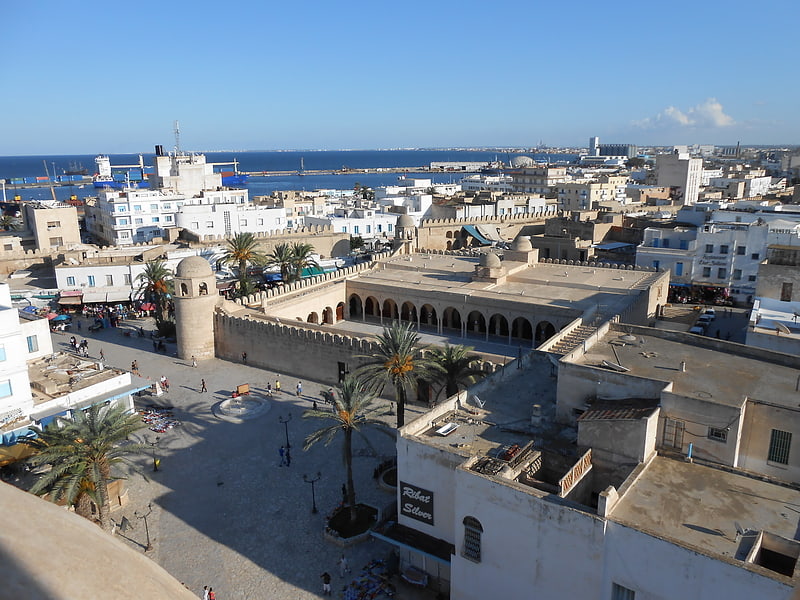
Also known as: مدينة سوسة العتيقة
Monument in Sousse, Tunisia. The Medina of Sousse is a Medina quarter in Sousse, Governorate of Sousse, Tunisia. Designated by the UNESCO a World Heritage Site in 1988, it is a typical example of the architecture of the early centuries of Islam in Maghreb. It encompasses a Kasbah, fortifications and the Great Mosque of Sousse. The Medina today houses the Archaeological Museum of Sousse. A number of Punic steles were discovered in the Medina, between the Ribat and the Great Mosque, in the 19th and 20th centuries.[2]
Medina of Tunis, Tunis

Also known as: مدينة تونس العتيقة
The Medina of Tunis is the medina quarter of Tunis, the capital of Tunisia. It has been a UNESCO World Heritage Site since 1979.
The Medina contains some 700 monuments, including palaces, mosques, mausoleums, madrasas and fountains dating from the Almohad and the Hafsid periods.[3]
Baths of Antoninus, Tunis
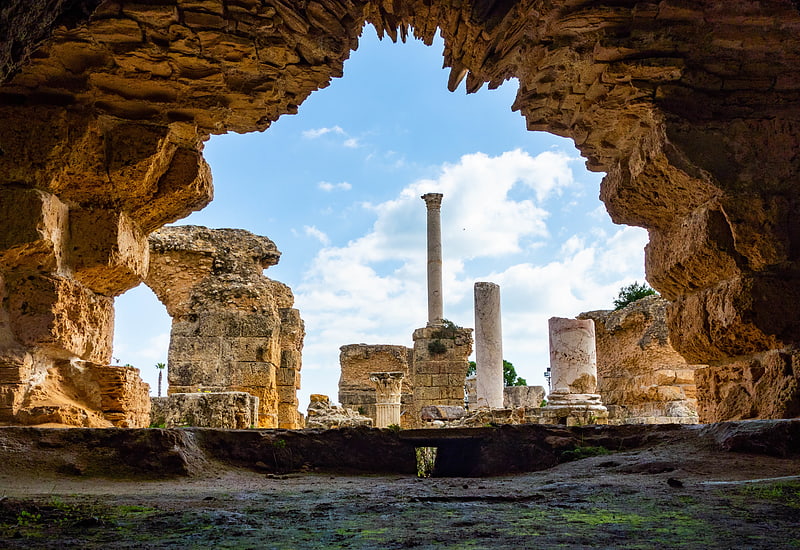
Also known as: حمامات أنطونيوس بقرطاج
Thermal baths in Tunisia. The Baths of Antoninus or Baths of Carthage, located in Carthage, Tunisia, are the largest set of Roman thermae built on the African continent and one of three largest built in the Roman Empire. They are the largest outside mainland Italy. The baths are also the only remaining Thermae of Carthage that dates back to the Roman Empire's era. The baths were built during the reign of Roman Emperor Antoninus Pius.
The baths are at the South-East of the archaeological site, near the presidential Carthage Palace. The archaeological excavations started during the Second World War and concluded by the creation of an archaeological park for the monument. It is also one of the most important landmarks of Tunisia.
The baths are today part of the Archaeological site of Carthage on the list of World Heritage sites of UNESCO. On 17 February 2012, the Tunisian government proposed the Roman hydraulic complex Zaghouan-Carthage, that the baths are part of, as a future World Heritage site.[4]
Great Mosque of Kairouan, Kairouan

Also known as: جامع عقبة بن نافع
Sprawling mosque complex from 670 CE. The Great Mosque of Kairouan, also known as the Mosque of Uqba, is a mosque situated in the UNESCO World Heritage town of Kairouan, Tunisia and is one of the most impressive and largest Islamic monuments in North Africa.
Established by the Arab general Uqba ibn Nafi in the year 50 AH (670AD/CE) at the founding of the city of Kairouan, the mosque occupies an area of over 9,000 square metres (97,000 sq ft). It is one of the oldest places of worship in the Islamic world, and is a model for all later mosques in the Maghreb. Its perimeter, of about 405 metres (1,329 ft), contains a hypostyle prayer hall, a marble-paved courtyard and a square minaret. In addition to its spiritual prestige, the Mosque of Uqba is one of the masterpieces of Islamic architecture, notable among other things for the first Islamic use of the horseshoe arch.
Extensive works under the Aghlabids two centuries later (9th Cent.AD/CE) gave the mosque its present aspect. The fame of the Mosque of Uqba and of the other holy sites at Kairouan helped the city to develop and expand. The university, consisting of scholars who taught in the mosque, was a centre of education both in Islamic thought and in the secular sciences. Its role at the time can be compared to that of the University of Paris in the Middle Ages. With the decline of the city from the mid-11th century, the centre of intellectual thought moved to the University of Ez-Zitouna in Tunis.[5]
Address: Rue De La Kasbah, 3100 Kairouan
Kether Torah Synagogue of Sousse, Sousse
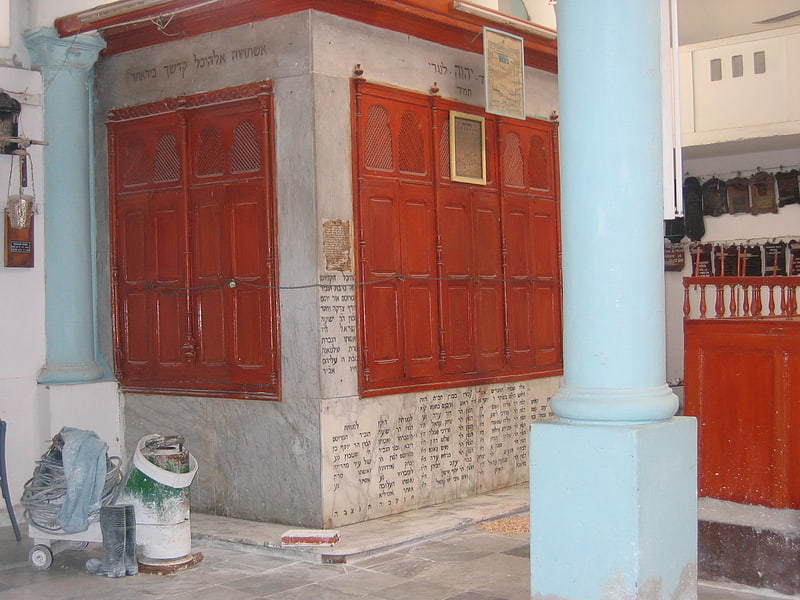
Synagogue. Keter Torah Synagogue is a Jewish Synagogue in the Tunisian city of Sousse.[6]
Sousse Archaeological Museum, Sousse
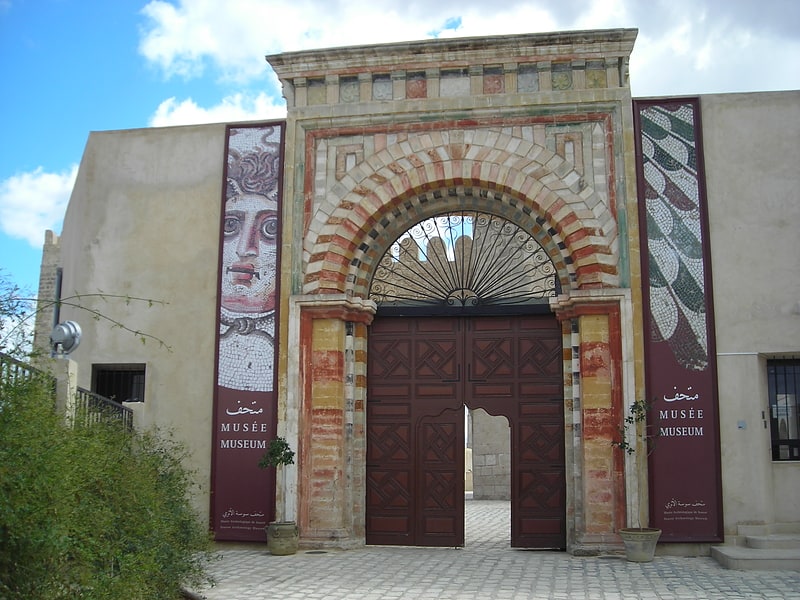
Also known as: المتحف الأثري بسوسة
Museum in Sousse, Tunisia. The Sousse Archaeological Museum is an archaeological museum located in Sousse, Sousse Governorate, Tunisia.[7]
Address: Ave du Marshal Tito, 4000 Sousse
Mosque of the Three Doors, Kairouan

The Mosque of the Three Doors or Mosque of Muhammad ibn Khairun is a mosque In the city of Kairouan, Tunisia. Commissioned by Muhammad ibn Khairun in 866, it is one of the oldest mosques in the world, and one of the oldest existing testaments to Aghlabid-era architectural design.[8]
Bourguiba mausoleum, Monastir
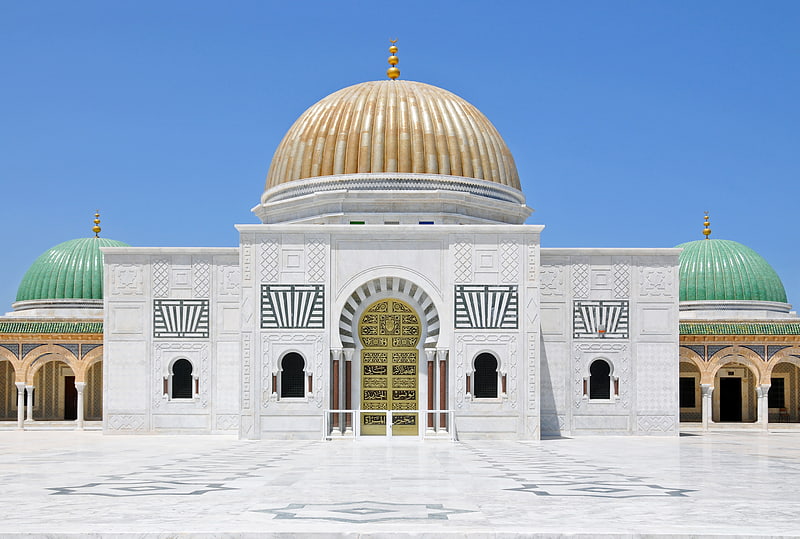
Also known as: ضريح بورقيبة
Museum in Monastir, Tunisia. The Bourguiba mausoleum is a monumental grave in Monastir, Tunisia, containing the remains of former president Habib Bourguiba, the father of Tunisian independence, who died on April 6, 2000.[9]
Hanafi Mosque of Bourguiba, Monastir
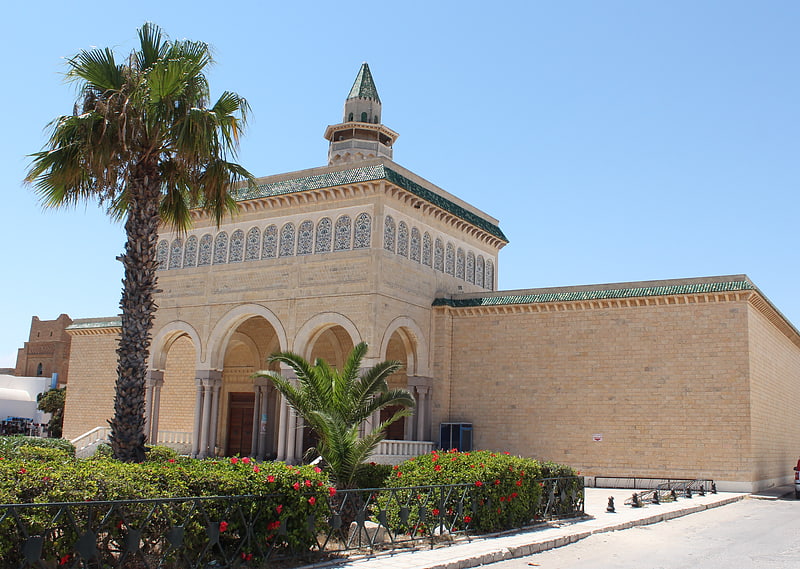
Also known as: جامع بورقيبة
Mosque in Monastir, Tunisia. The Hanafi Mosque of Bourguiba is a Tunisian mosque located in Monastir and dedicated to the first president of Tunisia, Habib Bourguiba.[10]
Ribat, Monastir
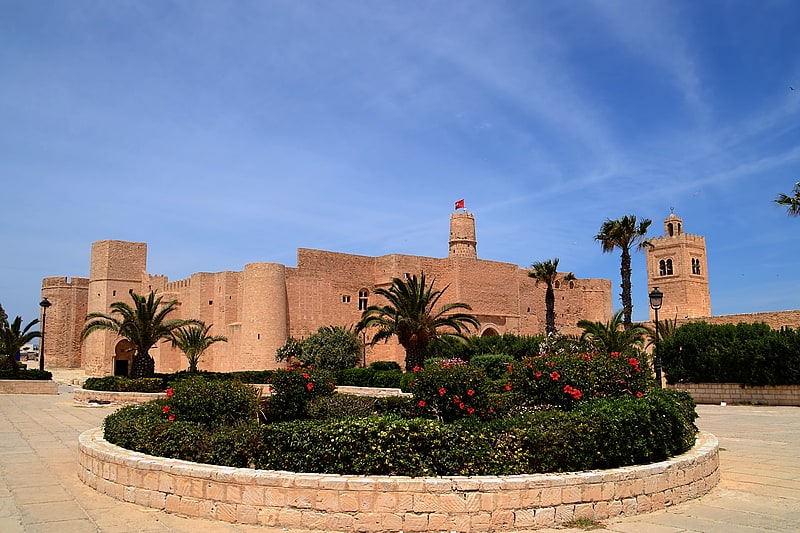
Also known as: رباط المنستير
Museum in Monastir, Tunisia. The Ribat of Monastir is a ribat, an Islamic defensive structure, located in Monastir, Tunisia. It is the oldest ribat built by the Arab conquerors during the Muslim conquest of the Maghreb. It is also the most prominent monument of the city of Monastir. Video360 on YouTube[11]
Mosque of the Three Gates / Mosquée des Trois Portes, Kairouan

Place of worship
Carthage National Museum, La Marsa
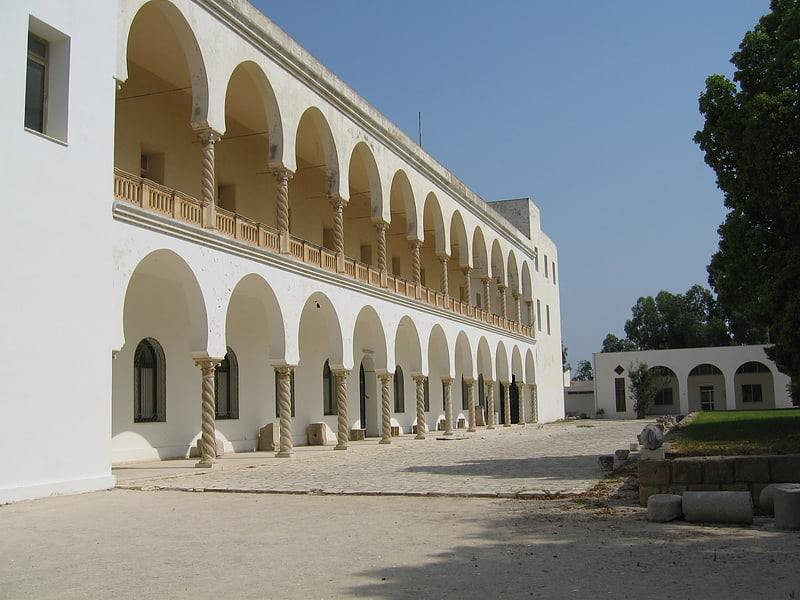
Also known as: المتحف الوطني بقرطاج
Small museum with ancient relics and art. Carthage National Museum is a national museum in Byrsa, Tunisia. Along with the Bardo National Museum, it is one of the two main local archaeological museums in the region. The edifice sits atop Byrsa Hill, in the heart of the city of Carthage. Founded in 1875, it houses many archaeological items from the Punic era and other periods.
In 1975, excavations exposed a Late Roman house with fragments of Roman mosaics and further off the property was a large church dating to the 5th century. Building plans to create a site museum went into effect in 1983; a year later the museum opened through financial donations from 59 members of a non-profit organization EARTHWATCH. The museum is a collaboration of specialists and volunteers who dedicated their talents and resources to preserve the threatened site of the ancient Mediterranean, Carthage.
The Carthage National Museum is located near the Cathedral of Saint-Louis of Carthage. It allows visitors to appreciate the magnitude of the city during the Punic and Roman eras. Some of the best pieces found in excavations are limestone/marble carvings, depicting animals, plants and even human sculptures. Of special note is a marble sarcophagus of a priest and priestess from the 3rd century BC, discovered in the necropolis of Carthage. The Museum also has a noted collection of masks and jewelry in cast glass, Roman mosaics including the famous "Lady of Carthage", a vast collection of Roman amphoras. It also contains numerous local items from the period of the Byzantine Empire. Also on display are objects of ivory.[12]
Address: Byrsa Hill, 2016 Carthage
Libyco-Punic Mausoleum of Dougga, Dougga
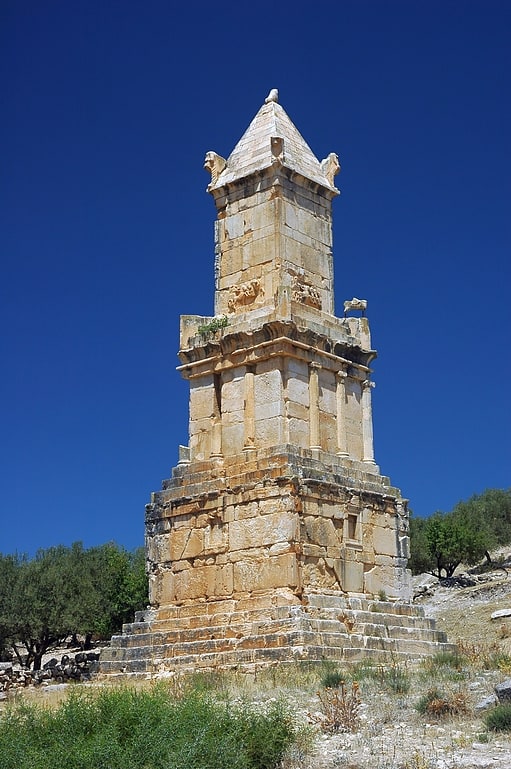
Also known as: الضريح اللوبي البوني
The Libyco-Punic Mausoleum of Dougga is an ancient mausoleum located in Dougga, Tunisia. It is one of three examples of the royal architecture of Numidia, which is in a good state of preservation and dates to the 2nd century BC. It was restored by the government of French Tunisia between 1908-10.
As part of the site of Dougga, the mausoleum is listed by UNESCO as a World Heritage Site. On 17 January 2012, the Tunisian government proposed it be included in a future classification of the royal mausoleums of Numidia and Mauretania and other pre-Islamic funerary monuments.[13]
Temple of Juno Caelestis, Dougga
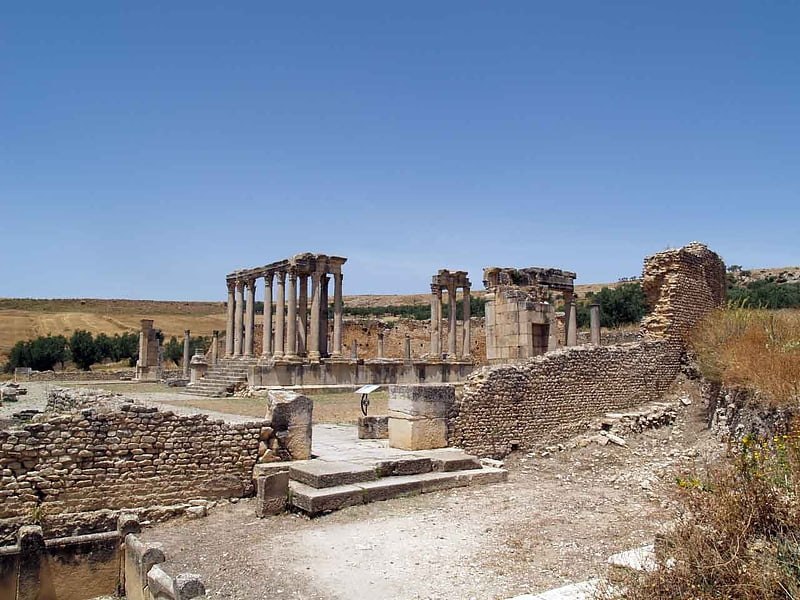
Historical landmark in Tunisia. The Temple of Juno Caelestis is a archaeological site in Dougga, Tunisia. The ruined temple was dedicated to the Roman goddess Juno, herself an evolution of the Punic goddess Tanit. The temple was built between 222 and 235 AD, and is one of the best preserved temples dedicated to Juno in Africa.[14]
Aïn Doura Baths, Dougga

The Aïn Doura Baths are a series of Roman-era ruins located in Dougga, Tunisia. The site contains ruins from a Roman bath dating to the 4th century, and is considered an important archaeological heritage site by the National Heritage Institute of Tunisia.[15]
Ennejma Ezzahra, La Marsa

Also known as: النجمة الزهراء
Palace in Carthage, Tunisia. Ennejma Ezzahra, sometimes spelled Nejma Ezzohara, also The Palace of the Baron d'Erlanger is a historical palace at Sidi Bou Said, in northern Tunisia, built from 1912 - 1922 by Baron Rodolphe d'Erlanger as his home in Tunisia. It is considered to be an outstanding example of Arab-Islamic architecture in Tunisia and was built historic elements by craftsmen from Tunisia. After the independence of Tunisia in 19, it was the first museum to be opened in the country.[16]
Address: Rue du 2 Mars 1934, La Marsa
Borj El Kebir, Houmt El Souk
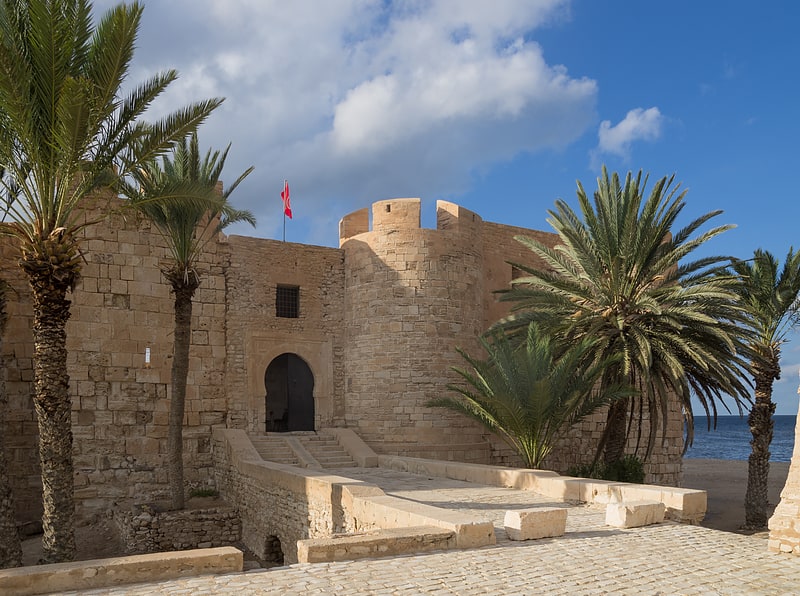
Also known as: برج الغازي مصطفى
Castle. Borj El Kebir, also known as Borj El Ghazi Mustapha, is an ancient castle in Houmt El Souk, Tunisia on the island of Djerba. It is the largest and best preserved local castle, and is one of the most visited historical sites on the island.[17]
El Ghriba Synagogue, Djerba
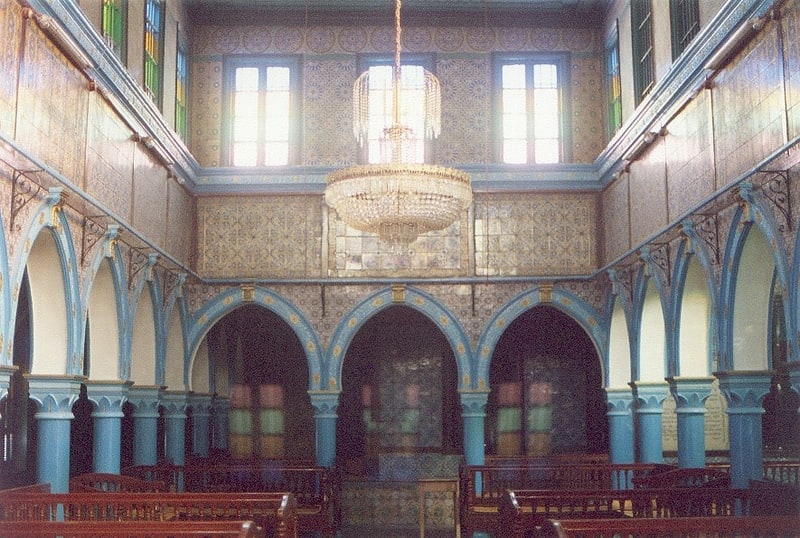
Also known as: كنيس الغريبة
Synagogue in Tunisia. The ancient El Ghriba Synagogue, also known as the Djerba Synagogue, is located on the Tunisian island of Djerba. It is situated in the Jewish village of Hara Seghira, several kilometres southwest of Houmt El Souk, the main town of Djerba.
The synagogue is the oldest in Tunisia, and besides being the center of the island's Jewish life is also a site of pilgrimage, one of the legends associated with its founding claims that either a stone or a door from Solomon's Temple or the Second Temple is incorporated in the building.[18]
Synagogue Keren Yéchoua, La Marsa
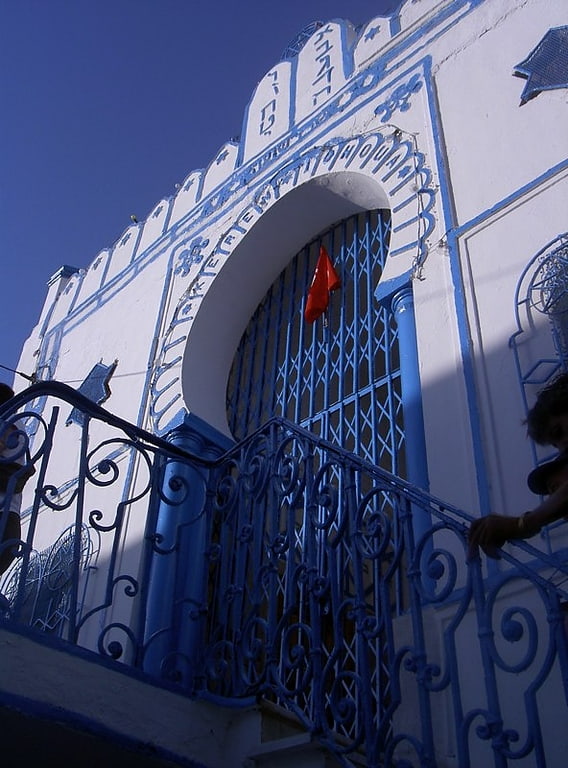
Keren Yeshoua Synagogue, often written as Keren Yéchoua or Keren Ichoua, is a Jewish synagogue in the Tunisian town of La Marsa, a suburb of Tunis.[19]